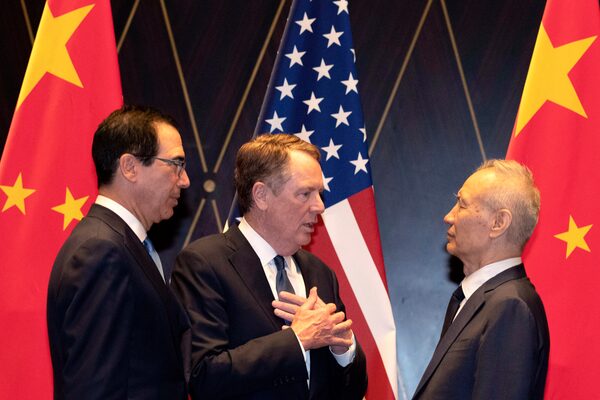
U.S. Trade Representative Robert Lighthizer, center, gestures as he chats with Chinese Vice Premier Liu He, at right with Treasury Secretary Steven Mnuchin, left, at the Xijiao Conference Center in Shanghai on July 31, 2019.Ng Han Guan/The Associated Press
Top U.S. and Chinese trade officials reaffirmed their commitment to a Phase 1 trade deal and discussed how to increase lagging Chinese purchases of American goods, lending support to financial markets on Tuesday.
The pledge was made in a telephone call between U.S. Trade Representative Robert Lighthizer, U.S. Treasury Secretary Steven Mnuchin and Chinese Vice-Premier Liu He – their first formal discussion since early May – amid concern the deal could be on shaky ground because of worsening U.S.-China ties.
“Both sides see progress and are committed to taking the steps necessary to ensure the success of the agreement,” the U.S. Trade Representative’s office (USTR) said in a statement after what it described as a regularly scheduled call.
The call was originally expected on Aug. 15, the six-month anniversary of the deal’s launch, but was delayed by U.S. President Donald Trump, who had told reporters he was still angry at Beijing over the coronavirus pandemic.
With Mr. Trump’s Republicans holding their political convention this week, top Trump aides have sought to put a positive spin on the trade deal, saying in recent days they were satisfied with China’s implementation as purchases of U.S. farm goods ramp up from a slow start that has put Beijing well behind initial targets.
White House trade adviser Peter Navarro, a vocal China hawk, told reporters on Tuesday the trade deal was “alive and well. They’re buying the corn, the soybeans, the pork, the beef that they said they would.”
Tensions between Washington and Beijing have grown over the coronavirus and issues ranging from a new national security law imposed on Hong Kong to U.S. sanctions against Chinese tech firms accused of threatening U.S. national security.
China’s Commerce Ministry confirmed the two sides had a “constructive dialogue” and agreed to continue pushing forward the implementation of the Phase 1 trade deal.
The USTR said they “addressed steps that China has taken to effectuate structural changes” on issues including protecting intellectual property rights, removing impediments for U.S. companies in the financial services and agriculture sectors and eliminating forced technology transfers.
“The parties also discussed the significant increases in purchases of U.S. products by China as well as future actions needed to implement the agreement,” it said.
News of the call helped lift global stocks and Asian currencies. On Wall Street, the call added to recent positive sentiment, but it was overshadowed by a drop in Apple Inc. shares that kept major indexes largely flat.
‘KEEP BUYING’
Chinese purchases of U.S. goods are running well behind the pace needed to meet a first-year increase of US$77-billion specified in the deal, according to official data.
While China has recently ramped up buying of farm goods including soybeans, it is far from meeting its commitment to buy US$36.5-billion worth of U.S. agricultural goods under the deal – purchases Mr. Trump has counted on to bolster his support in farm states that backed him in the 2016 election.
The United States exported just US$7.274-billion in agricultural goods to China in the first half of the year, according to the U.S. Census Bureau.
The U.S. comments “showed that they think we are going to keep buying from the U.S., at least before the election takes place. And we will,” an agricultural goods trader with a Chinese state-owned firm said, declining to be identified as he is not authorized to speak to media.
“We are definitely going to maintain the stance to buy as much as possible, but it is really hard to say whether the targets can be reached.”
Sushant Gupta, research director at the Wood Mackenzie consultancy, said it expects China to import more American liquefied petroleum gas, propane and ethane in the second half of this year to meet petrochemical feedstock shortages, but does not expect China to be able to increase U.S. crude imports enough to meet the Phase 1 targets.
China bought only 5 per cent of the targeted US$25.3-billion in energy products from the United States in the first half of 2020. Chinese state-owned oil firms have booked tankers to carry at least 20 million barrels of U.S. crude for August and September.
Be smart with your money. Get the latest investing insights delivered right to your inbox three times a week, with the Globe Investor newsletter. Sign up today.